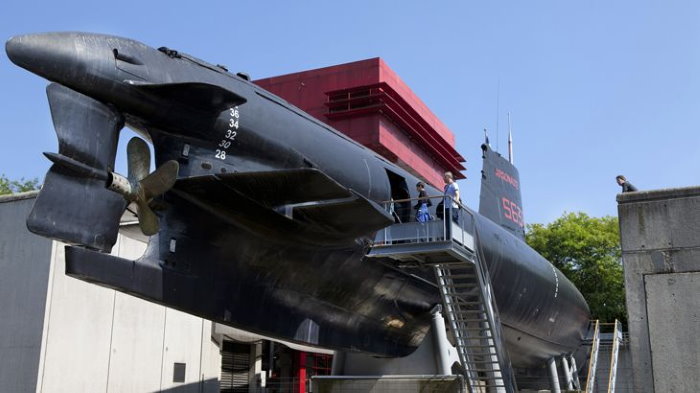Cité des Sciences, Paris science museum

Cité des Sciences is the largest science museum in Paris. Housed in a redesigned slaughterhouse, it is the top attraction of Parc de la Villette, a large park in the eastern side of the city. Paris museums. Museums for kids.
Cité des Sciences facts
La Cité des Sciences (Paris Science Museum) is a modern 30 000 m2 museum in Parc de la Villette. The world class Cité des Sciences features a good children section, called La Cité des enfants.
La Cité des Sciences is worth a visit in its green and relaxing environment. Combine it with Cité de la Musique, La Géode and Parc de la Villette.

Paris Science Museum
Cité des Sciences visits
Paris metro: Porte de La Villette station, line 7. Buses: 150,152,250A. Parking at the museum. Locate Cité des Sciences on Paris map.
Closed on Monday. Open from Tuesday to Saturday 10am to 6 pm, Sunday 10am to 7pm. Buy Cité des Sciences tickets (15 euros).
Paris 75019 France

Cité des Sciences Paris
Stay in top Paris hotel

Cité des Sciences hotel
Hotel Restaurant Au Boeuf Couronné offers pet-friendly accommodation with free WiFi in Paris, a 3-minute walk from the park. Guests can enjoy the on-site restaurant, one of the best meat restaurants in town, and bar. The air-conditioned rooms include a flat-screen TV with satellite channels. The rooms have a private bathroom with a shower, free toiletries and a hairdryer. All rooms are serviced by a lift. An American breakfast is served daily at the hotel. There is a terrace, a 24-hour front desk and a luggage storage on site.
Paris 75019 France

Au Boeuf Couronné hotel is near La Villette

Argonaute in Cité des Sciences Paris
Cité des Sciences permanent exhibitions
Brain: It is impossible not to marvel at the human brain which controls all of our actions, our thoughts, our perceptions, our abilities, our feelings? In this exhibition, where the atmosphere inspired by the surrealist movement combines the unusual with the dream-like, find out how your brain works and try out its capabilities through a variety of games, tests and experiments.
Man And Genes: evolution, heredity and what we are. This thought-provoking exhibition is split into four parts: Life forms and Evolution follows the incredible story of evolution, the role of genes explores the microscopic world of cells and explains how genes influence the development of living beings, genetic Engineering presents key research into the genome and the possibilities it has opened up, the final part of the exhibition, questions for society, focuses on bioethics, preparing us for the debate on the benefits and dangers of genetic manipulation.
Transport and mankind: mobility is of fundamental importance to modern society, as people need access to resources. The amount of travelling we do has steadily increased since the mid-20th century. If this trend continues, it will cause global social and health problems, and major environmental damage. It is now essential to rethink our transport systems and how they affect the area we live in.
Transport and Mankind explores the theme of human mobility from a socio-technological perspective, focusing on changes in individual and public transport, network efficiency, traveller comfort and safety, technological innovation and eco-friendly behaviour.
Energy:energy consumption worldwide increased tenfold during the 20th century. Today, faced with massive population growth, the development of emerging countries, global warming caused by excessive burning of fossil fuels, and finite oil and natural gas resources, we must approach energy in a completely new way. How can we satisfy our energy needs in the future? This exhibition explores different ways of meeting this challenge.
The great story of the universe is an ambitious exhibition on two levels which takes visitors on a journey of discovery into the origins of the universe. Travelling from planet Earth to the extragalactic void, you will find out how matter, light and energy are connected, and meet the great scientists who formed our conception of the universe and established the laws of physics, linking the infinitely small and the infinitely large.
Visitors to Earthwatch: the satellite revolution are confronted with a radically different viewpoint: planet Earth observed by the thousands of satellites in orbit around it. This 1000-square-metre exhibition is in two parts: monitoring the Earth, which reveals how countless human activities depend on space technologies. Journey into Space, which shows how science and technologies have shaped the history of space conquest.
Mathematics: Some real-life and easy-to-grasp applications help us to understand movement, calculate probability or model physical phenomena and more.
Sounds
Discover the Argonaute: In the middle of Paris, bring your family to see the living conditions aboard a real hunter-killer submarine from the 1950s. The Argonaute is a submarine museum, berthed in the Parc de la Villette since 1989. Its audio-guided tour offers a glimpse into the daily life of a 40-man team. On the inside, decorations and photographs from the time help visitors to imagine themselves as submariners. In this visit, the secret world of the submariners will be revealed! In particular, you will learn about the practice of "hot racking", discover the technical complexity of such a construction and understand why the Argonaute was such a unique way to collect information and run special operations. On leaving the submarine, the new exhibition "Under the Ocean" completes the visit and looks at this environment to explore the seabed from a scientific, technological and geopolitical perspective.